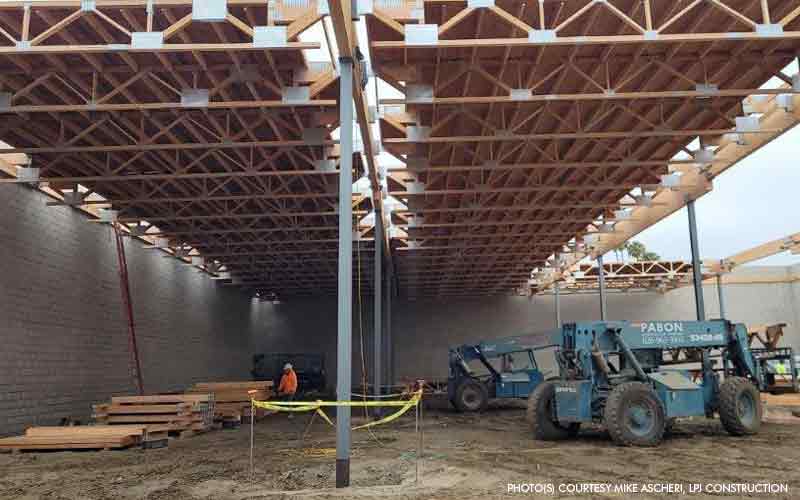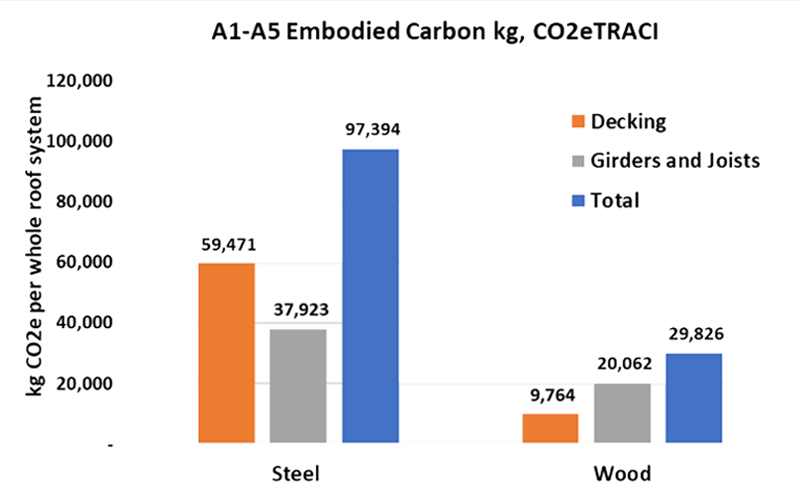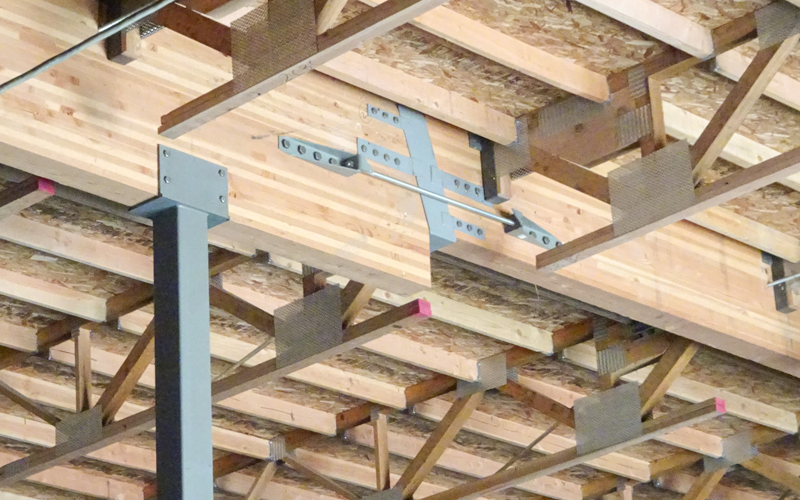Sprouts Farmers Market, a grocery store specializing in fresh produce and healthy products, offers a familiar presence throughout the country. The store interiors are open and airy, with easy visibility from nearly every vantage point.
For many years, the company’s design and construction teams have relied on steel to achieve that look and layout. But for a new location in Norwalk, California, material logistical challenges led the project team down a path to engineered wood. The result showcases engineered wood’s capabilities in achieving span and load capacities with little to no sacrifice of the project’s core design details.
A Grocery Store Built with Wood
Originally, the store was designed as other Sprouts Markets have been, with an entirely steel roof system—a metal deck, steel girders and a steel bar-joist system. But long lead times for steel necessitated a change in materials. Engineer Mo Kateeb, principal of A.V. Schwan & Associates, turned to wood component manufacturer G2 National to discuss wood alternatives that would still preserve the store’s signature look and volume, as well as performance in the high seismic area.
“Sprouts is the best-looking building on the market, especially the floor. We pay a lot of attention to that,” said Kateeb. “I like the building because of the openness of it. The bright, clean colors. It gives you the vibe that it’s somewhere I want to buy my food from.”
Kateeb had used engineered wood for commercial projects in the past, but largely for multifamily buildings. G2 National worked with the engineer to determine which wood systems could replicate the design and performance that steel had been providing, including confirming the manufacturer could accommodate the spans at the depth needed.
The new engineered wood roof system comprised of glulam girders from APA member DR Johnson Wood Innovations spanning 36 feet, an oriented strand board (OSB) deck, and G2’s G2T 8-foot o.c. panelized wood-plated truss system with laminated veneer lumber (LVL) top and bottom chords. Using the higher strength LVL from APA member Roseburg Forest Products increased the roof supports’ bending capacity and allowable span to compete with the steel bar-joist system. The G2T system uses flush hangers, similar to the original steel system.

Though it’s a light-frame system, few concessions were needed from the original steel design except for a slightly lower clear height (8 inches) due to a deeper truss depth; however, the added purlin depth is offset by using fewer overall purlins due to the wider 8-foot spacing of the wood trusses versus the 6-foot spacing required for steel. The revised height was well within the minimum clear height for Sprouts’ equipment and décor, and Kateeb coordinated all exposed ductwork without conflict.
“We were able to design a series of trusses that were a higher-grade material (LVL) to achieve getting the system within the available cavity,” said Dave Roti, national marketing & licensing manager for G2 National. “That’s routine for us, and we were able to replicate the design how they wanted it.”
G2 worked with Kateeb to provide current details for hangers, seismic walls, truss straps and more. “This wasn’t a brand-new concept for the engineer and architect, but the detailing of it was a collaboration,” Roti said.
Kateeb adjusted the way the walls were anchored, with straps, hold-downs and diaphragm anchors supporting the reinforced masonry walls out-of-plane to accommodate seismic loads.
“The transition process was fairly easy—we’re well-versed in wood design and attend APA webinars,” Kateeb said. “We were able to coordinate hand-in-hand with Dave Roti and his team to smooth the process—we ran numbers by them for capacities and gravity or seismic loads, as well as to try to work out any detailing beforehand so we were all on the same page. Having a truss manufacturer on board helped smooth the project.”
Using the engineered wood system helped speed up the installation process, including eliminating the need for certified welders on-site and additional inspectors. G2 recommended a local contractor with experience in panelized roofs, which further helped the coordination and construction move efficiently and quickly. As an added bonus, the exposed wood brings warmth that further amplifies the store’s natural feel.
Switching from Steel to Wood Significantly Reduced Carbon Emissions
Along with keeping the project on track, replacing the steel roof system with a panelized wood system dramatically reduced the grocery store’s carbon footprint.
A life-cycle assessment (LCA) was conducted on the entire roof system by third-party firm WoodLife Environmental Consultants on behalf of APA to analyze the energy required during manufacturing, product transport to site, and construction. The LCA found that using a wood roof design rather than steel for the Norwalk Sprouts lowered the roof system overall embodied carbon by 69%. And just by switching the roof deck from metal decking to Oriented Strand Board (OSB), the design team was able to reduce the CO2e by 49,707 kg, as shown in the figure below. That one change accounted for 51% of the reduction in the total CO2 emissions of the roof system. Learn more about LCAs and emissions in building construction here.

To further the decarbonization gains, some environmentally minded companies are considering the switch from tilt-up concrete walls to cross-laminated timber (CLT), allowing for the same interior volume but a much smaller carbon footprint.
Though the move to a light-frame engineered wood roof system was initially done out of necessity, the benefits revealed during the process have led to replication of the wood design for some future Sprouts locations.
Kateeb has been working with large wood projects for a long time and on Sprouts Farmers Market projects for nearly a decade, but this was his first Sprouts building to forego a high-embodied carbon steel roof system. “This definitely opened my mind to using the engineered wood system in a grocery store because it was able to withstand the load on the roof and the spans.”
Get help designing your next sustainable structure! APA Engineered Wood Specialists are located across the U.S. and Canada and provide complimentary consultations for architects, engineers and other building professionals on the application and specification of engineered wood products. Learn more or contact your local representative.







